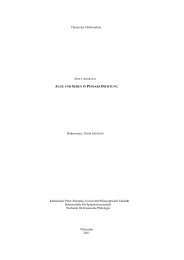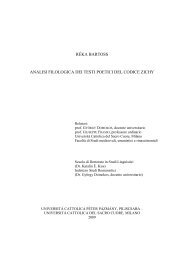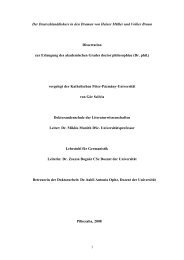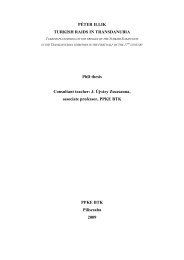tézisfüzet angol - Index of - Pázmány Péter Katolikus Egyetem
tézisfüzet angol - Index of - Pázmány Péter Katolikus Egyetem
tézisfüzet angol - Index of - Pázmány Péter Katolikus Egyetem
Create successful ePaper yourself
Turn your PDF publications into a flip-book with our unique Google optimized e-Paper software.
I. Preliminaries to the research<br />
His contemporaries as well as literary and science historians <strong>of</strong> the 18–<br />
19th centuries considered Georgius Buchholtz jun. (1688–1737) as one <strong>of</strong> the<br />
most erudite people <strong>of</strong> his age, an outstanding scientist, preacher, teacher, and not<br />
least an excellent poet, however his name became almost totally forgotten by the<br />
second half <strong>of</strong> the 20th century. Buchholtz, born in Késmárk (today Kežmarok,<br />
Slovakia), noted day by day between 9th May 1709 and 25th July 1737 into his<br />
near 3000-pages-long diary what happened to him and in his environment, where<br />
he went, who he met, who he sent to and received from letters, what he read, what<br />
he wrote, what he taught at school, what he ate, what he bought, how he spent his<br />
free time. The manuscript, preserved in the Slovakian National Library (earlier<br />
Matica slovenská) in Turócszentmárton (today Martin, Slovakia; signature:<br />
C24/1–2), contains a great deal <strong>of</strong> information on everyday life, education, the<br />
Evangelical denomination, the world <strong>of</strong> science etc. The diary, forgotten for a<br />
long time, practically until now rested – apart from the examination <strong>of</strong> some<br />
smaller parts – unprocessed d unpublished. The aim <strong>of</strong> this dissertation is to<br />
analyse the diary, completing the information in it and the presentation <strong>of</strong> the<br />
author’s wide activity with data from other sources, manuscripts and printed<br />
material as well. The approach to the text is basically from cultural historical<br />
point <strong>of</strong> view, but I also examine it as a literary work.<br />
Studying the secondary literature one can find the name<br />
Georgius/György/Georg/Juraj Buchholtz jun. in many kinds <strong>of</strong> works. He is a<br />
constant character <strong>of</strong> biographical lexicons, histories <strong>of</strong> different branches <strong>of</strong><br />
science, church and school; most <strong>of</strong> the short references, however, contain quite a<br />
number <strong>of</strong> inaccuracies. The literature dealing directly with Buchholtz is less rich.<br />
At the beginning <strong>of</strong> the 20th century Samu Weber, Rudolf Weber, Johann Lipták<br />
did research on the family, especially the older and younger Georgius as<br />
preachers, teachers, scientists and explorers <strong>of</strong> the Tatra mountain. In the 1950–<br />
2






